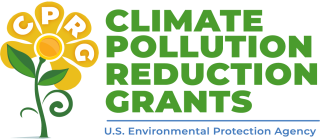 April 24, 2024 — The U.S. Environmental Protection Agency (EPA) recently announced that a record 45 states, plus the District of Columbia, Puerto Rico, and dozens of Metropolitan Statistical Areas, have now developed climate action plans through investments made possible by President Biden’s Investing in America agenda. The planning process is supported by EPA’s Climate Pollution Reduction Grants program, which offers a unique opportunity to help state and local governments develop strategies to reduce harmful pollution and address environmental justice concerns, while building the infrastructure, industry, and competitive economy for a clean energy future. Together, over 96% of the U.S. population is covered by these plans.
April 24, 2024 — The U.S. Environmental Protection Agency (EPA) recently announced that a record 45 states, plus the District of Columbia, Puerto Rico, and dozens of Metropolitan Statistical Areas, have now developed climate action plans through investments made possible by President Biden’s Investing in America agenda. The planning process is supported by EPA’s Climate Pollution Reduction Grants program, which offers a unique opportunity to help state and local governments develop strategies to reduce harmful pollution and address environmental justice concerns, while building the infrastructure, industry, and competitive economy for a clean energy future. Together, over 96% of the U.S. population is covered by these plans.
The Climate Pollution Reduction Grants program created under the Inflation Reduction Act — the largest climate investment in history — is enabling community-driven solutions to the climate crisis and helping accelerate America’s clean energy transition. The program is covered under President Biden’s Justice40 Initiative, which set the goal that 40% of the overall benefits of certain federal climate, clean energy, and other investments flow to disadvantaged communities that are marginalized by underinvestment and overburdened by pollution.
In 2023, under the first phase of the $5 billion program, EPA made a total of $250 million in grants available to 45 states, the District of Columbia, Puerto Rico, 80 MSAs, four territories, and over 200 Tribes and Tribal consortia to develop ambitious climate action plans that address greenhouse gas emissions across their communities and economies.
Jennifer Macedonia, Deputy Assistant Administrator for EPA’s Office of Air and Radiation said:
The diversity of ideas and ambitious initiatives from all across the country reflect the seriousness that states and metropolitan areas are bringing to the work of cutting pollution, acting on climate change, and meeting their local objectives. These climate action plans demonstrate substantial progress for states and local governments, in coordination with their communities, to chart their path forward — building healthy communities and competitive local economies where climate solutions can thrive.
As part of the deliverables due under the initial $250 million planning phase of the program, grantees were provided resources to develop and submit Priority Climate Action Plans focused on high-priority, implementation-ready actions to reduce GHG emissions that were due for states and large metropolitan areas on March 1. Although Tribal and territory PCAPs are due April 1, EPA has already received 19 plans from Tribes.
Each grantee can align the measures selected for the PCAP with their jurisdiction’s unique priorities and interests while prioritizing measures that can benefit low-income and disadvantaged communities. For many states and metro areas, PCAPs are their first climate action plans. For others, the PCAPs build on existing climate action plans and work undertaken over many years.
In addition to addressing climate pollution, these grants can also support efforts to:
- Help businesses capitalize on new opportunities, spur economic growth and create jobs by supporting new industries, and developing training programs to prepare workers;
- Ensure communities, particularly low-income and disadvantaged communities, have a seat at the table, help define solutions, and benefit from their implementation; and
- Gain substantial public health co-benefits through the simultaneous reduction of criteria.
The submitted PCAPs lay the groundwork for the second phase of the CPRG program: $4.6 billion in competitive implementation grants that planning grant recipients and other eligible entities can use to fund GHG reduction measures contained within the PCAPs. PCAPs also help prepare states and metro areas for accessing a broader set of funding opportunities, including other programs under the Investing in America agenda.
All planning grant recipients will also develop Comprehensive Climate Action Plans (due in the second half of 2025 for most grantees), which will include a broader suite of GHG reduction measures from all key emitting sectors — electric power, transportation, commercial and residential buildings, industry, agriculture/natural and working lands, and waste and materials management. The comprehensive plans will also contain GHG emissions projections and reduction targets, air quality and health benefits information, and workforce planning assessments. EPA is committed to providing grant recipients with technical support, tools, and other resources throughout the planning process.
Together, the CPRG planning grants and competitive implementation funding will support the deployment of technologies to reduce GHG emissions and other harmful pollution across the country, facilitate the transition to a low-carbon economy, and advance environmental justice by prioritizing benefits to communities.
View the Priority Climate Action Plans from CPRG planning grantees
More information on the Climate Pollution Reduction Grants
CPRG Training, Tools and Technical Assistance
Sign up for notifications about the Climate Pollution Reduction Grants program




